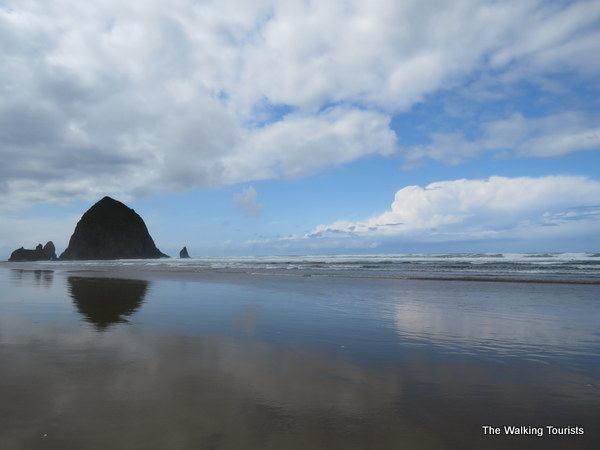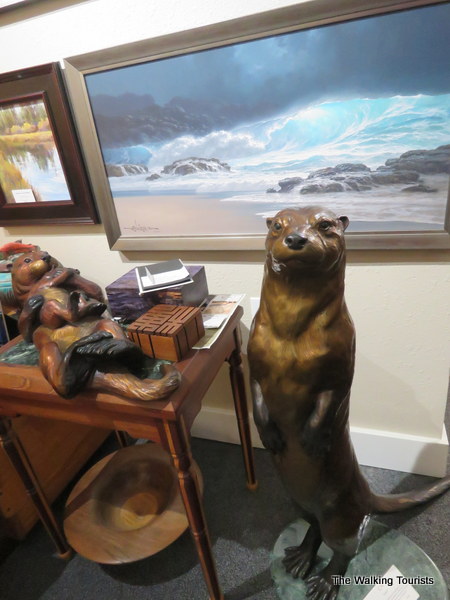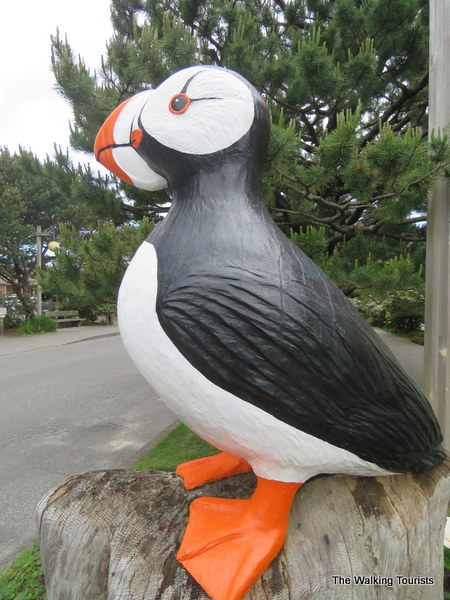Oregon visit combines history and nature

Northwest Oregon’s beauty abounds. We enjoyed an entertaining drive along Route 101, from Long Beach, Washington, to Cannon Beach, Oregon. Our trip mixed history with nature, as well as some manmade attractions.
The drive itself is worth the trip. Seeing parts of the Pacific Ocean and the Columbia River was impressive. Our first encounter with history was the Astoria-Megler Bridge that connects Washington and Oregon. The truss bridge, completed in 1966, is the world’s longest continuous bridge at about 4.1 miles long. It was the last piece of construction completed to complete the 101 from Olympia, Washington, to Los Angeles.

I fell in love with the moss’ attractiveness on the rocks along the river shore. The moss’ color was so vivid.

We continued our drive along the 101 to Cannon Beach. The city is known for a giant rock sticking out of the Pacific Ocean. Haystack Rock has been around for centuries. The Lewis and Clark expedition even saw it. The rock is beautiful.

Haystack Rock stands near the city’s beach. During low tide, it’s accessible by foot. Our daughter Mallory thought it resembled a dragon when you look at the rocks near it.
Cannon Beach is beautiful. The beach was clean. As the water rolled in and out, you could catch reflections in the wet sand. Gulls lined up near the water, likely looking for a free meal.

Canon Beach is more than Haystack Rock. The city center offers visitors diverse attractions. We settled on a couple of shops that piqued our interest. One was a chocolate shop. The second was an art gallery. Both had some beautiful items on display.

As you stroll around Cannon Beach, you are likely to encounter some public art, including wooden statues featuring a puffin or boat captain.

Seaside is proud of its link to the Lewis and Clark expedition in the early 1800s. The mouth of the Columbia River, a short drive north along the Oregon-Washington state border, was the final destination for the Corps of Discovery. The expedition was sent to explore transportation routes and trade opportunities with Native Americans following the Louisiana Purchase.
A statue recognizing the duo stands along the beach in a traffic circle. I liked the location of the statue, with the leaders looking out to the Pacific Ocean, seemingly recognizing the historic fete.

Seaside is home to a small aquarium. The seaside Aquarium’s main attraction is a group of seals that visitors can feed for an additional fee above the $8 admission. The aquarium is one of the oldest in the United States, having been founded in 1937.
We enjoyed feeding the seals. There are 11 of them, and they are allowed to move freely from their primary tank to the feeding area. Each seal has a personality and encourages visitors to feed it with its own style. Some may bark. Some may move about on the rock. One, in particular, was a bit bossy by splashing visitors when it felt it wasn’t getting its fair share (all of it) of the food.

The aquarium has underwater exhibits and a touch tank. The exhibits feature star fish, eels, octopus, as well as sea anemone.

Our last leg of the Oregon trek took us to Astoria, near the mouth of the Columbia River. The Lewis and Clark expedition spent the winter of 1805-06 along the south side of the river, a few miles away from present-day Astoria. We had to visit the Fort Clatsop National Historic Park. A life-sized replica of the fort is located at the park, likely near where they stayed.

The forest surrounding the fort was home to some tall and beautiful trees. I find the trees in the Pacific Northwest to be the most beautiful in our nation. I know others prefer Aspens for their color, as well as others. But, there is just something the dark green, tall trees that impresses me.

The visitors center offers a look at items that would have been used by the troops during the expedition, including boats carved from nearby trees.

Two minorities were along on the expedition. Sacajawea, a Shoshone Native American, joined her French-Canadian husband, helped guide the team. The couple had a baby during the expedition. Sacajawea carried the baby on her back in a carrier for much of the travels.

York was the lone African American. He was a slave who was owned by William Clark’s family. York’s “ownership” was passed to Clark following his father’s death. York worked a full member of the exploration, but wasn’t paid to perform the same duties as the soldiers. It’s speculated that following the expedition, he may have escaped or been freed.

Once in Astoria, we visited the Columbia River Maritime Museum. The museum is situated along the river. The building’s exterior resembles a boat.

The museum is well laid out. Visitors can view several types of boats that may be found in the area.
It offers outstanding exhibits exploring life on the river, as well as the ocean. The Columbia Bar has been considered one of the most dangerous water spots in the country. The bar is an area of water where the mouth of a river reaches the ocean. The bar consists of sediment and strong waves. The Columbia Bar is longer than five miles and about three miles wide.The US Coast Guard is responsible for handling rescue operations along the river. An exhibit realistically depicts a water rescue along the Columbia Bar.

Among the exhibits are a working lighthouse light and a World War II ship bridge.

Outside the building, visitors can check out the Lightship Columbia. The ship served as a floating lighthouse, beginning in the 1950s. It marked the entrance to the Columbia River. It was decommissioned in 1979.

Our final stop was the world famous Astoria Column. Celebrating its 90th year in 2016, the beautiful spiral building almost didn’t exist. The Astoria monument was supposed to the 12th in a series by Ralph Budd, who was president of the Great Northern Railroad. His goal was to have the monuments displayed along a route between St. Paul, Minnesota, and Astoria.

Budd’s plan called for a giant flag pole displaying a giant American flag. Those plans fell to the wayside once he met Electus Litchfield. The architect had a grander idea. He told Budd about an Italian artist who specialized in sgrafito style (basically applying artwork to plaster). They loved the idea. So, the flag pole was scrapped in favor of the column.
The Astoria Column stands 600 feet above the water. The column’s viewing platform is 125 feet tall in the column. The murals depict the history of the Columbia River, ending with the arrival of the railroad.

The view from the top of the Astoria Column is breathtaking. You can see the Columbia River and the surrounding beauty. If you look hard enough, you are supposed to be able to the Pacific Ocean in the far distance.

The park housing the column has some interesting exhibits. A monument honors the Chinook Native Americans.

Our last nature encounter was so worth the wait. As we were driving down Coxcomb Hill following our column visit, cars were stopped along the road as three young deer were making their way across. As they stopped to eat afterward, we were able to get some photos of them. They looked perfect.

Our visit to northwest Oregon allowed Lisa and I to check off Oregon on our list of states we need to visit. We loved the visit, and it offered a different opportunity from visiting a large city, such as Portland and its urban attractions. We still want to visit Portland, so that’s another trip to the “Beaver State.” But, regardless of where you visit, we strongly recommend making a trip to Oregon.
For more information on northwest Oregon or the state itself, please visit www.traveloregon.com.




